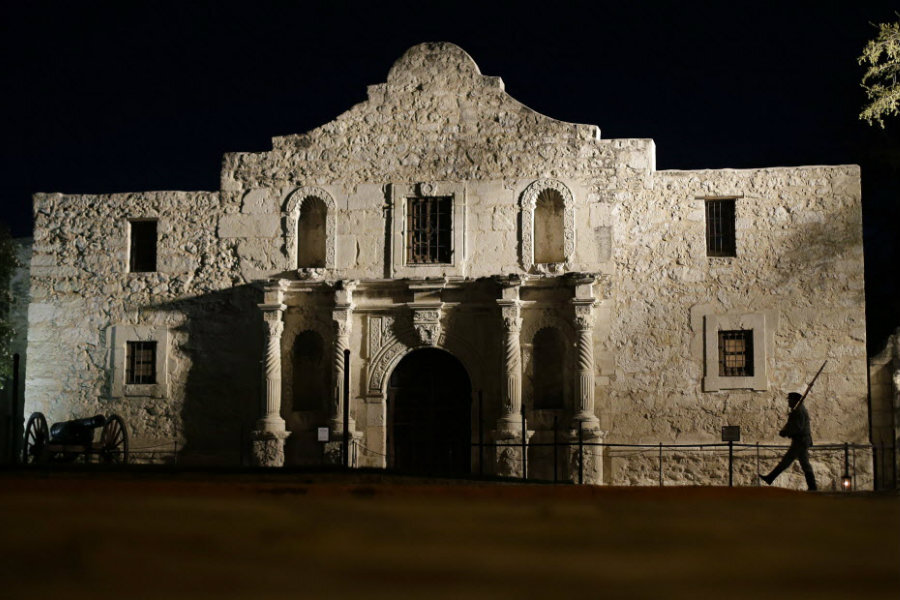As Alamo eyed for face-lift, officials debate how to rebuild
Loading...
| DALLAS
As the Alamo prepares for a face-lift of at least $48 million, some critics say the landmark – one of the most recognizable in US history – must be transformed from a one-dimensional attraction that's struggled to find its footing amid the clamor of downtown San Antonio.
The 18th-century former Spanish mission is poised to undergo one of its most significant alterations as Texas moves to buy nearby commercial buildings and hire a firm to develop a master plan over the next year that could change the area dramatically.
Some with a stake in the area say nearby attractions like Ripley's Haunted Adventure are too garish for the setting where some 190 men died defending the mission against the forces of Mexican Gen. Antonio Lopez de Santa Anna. Others say the landmark focuses too much on the battle that eventually gave way to Texas independence and not enough on its role as a cultural and commercial gateway.
"We've overly focused on March 6, 1836," said Jesus F. de la Teja, director of the Center for the Study of the Southwest at Texas State University.
Some critics say the Alamo could learn from neighboring attractions and offer catchier exhibits and displays.
"History in and of itself will not sell," said Davis Phillips, president and CEO of Phillips Entertainment. "History, presented in the right way, can sell."
Mr. Phillips owns three Alamo Plaza attractions including Ripley's and Guinness World Records Museum. The Texas General Land Office is moving to acquire the buildings housing those businesses across from the Alamo and possibly incorporate them into the mission's original footprint.
Phillips' ventures and other plaza businesses presumably would be relocated and the buildings used for other purposes, such as a museum with more than 200 artifacts donated by musician and Alamo aficionado Phil Collins.
State lawmakers have approved spending $31 million for repurposing the site. San Antonio officials have OK'd spending $17 million. But both state and city officials say private donations could raise the tally by hundreds of millions of dollars.
Phillips said neighboring family entertainment attractions that complement theAlamo experience should be included in the vision behind the changes. He said most visitors only spend a short time at the mission before heading to nearby businesses.
"There's been 170 years of development in the area," he said. "What I'm trying to tell everybody is that San Antonio is the No. 1 destination for leisure (in Texas) so let's be careful to not harm that."
The Daughters of the Republic of Texas managed the Alamo grounds for more than a century before the state took over the operations earlier this year. The Daughters of the Republic still maintains a research center there that includes a 38,000-item archival collection considered one of the most important in the state.
Daughters of the Republic president general Betty Edwards said any Alamo-related changes must be done with "reverence and respect" given its history as a burial site for Native Americans and the place where the bodies of the defenders of 1836 were piled and burned by Santa Anna's troops.
Edwards supports restoring the original footprint, but said a hotel, courthouse and other buildings encroach on that plan.
"We can combine entertainment with history without being Disneyland," she said.
She said a long-running dispute between her organization and the state, including an ongoing civil lawsuit over ownership of artifacts in the collection, has led to discussions with Texas A&M-San Antonio about moving the collection there.
San Antonio Conservation Society board member Sue Ann Pemberton said an Alamoalteration must include explanations about early settlements in the region, how commerce grew and the development that followed.
"The key issue is that we haven't told the story of that mission very well," she said.
Mr. De la Teja said the Alamo has been turned into a "living ruin" that doesn't capture the dynamic rise of the area in which many cultures built an important commercial hub over time.
"San Antonio grew up around it, so let's tell that story," he said.







